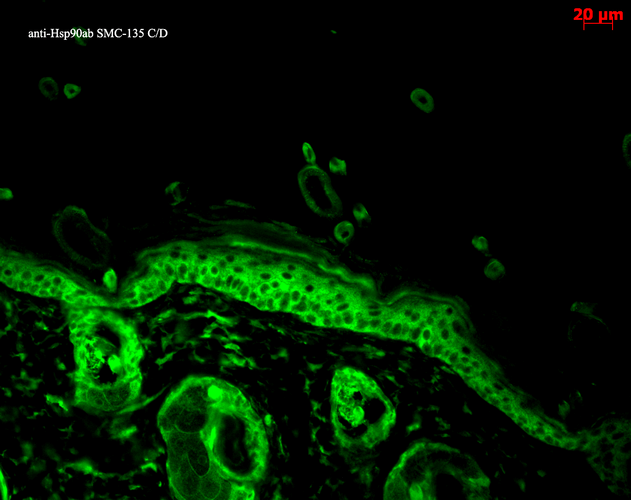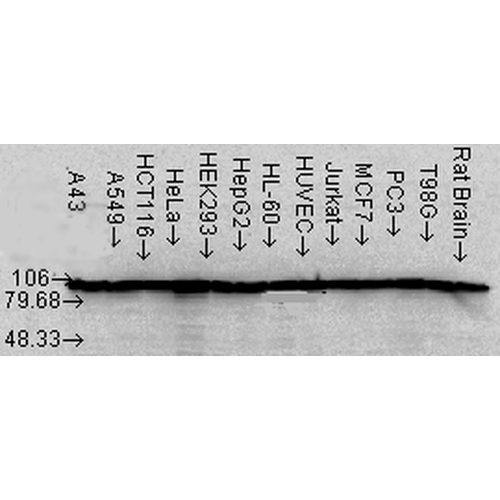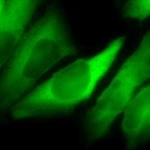Properties
| Storage Buffer | PBS pH7.2, 50% glycerol, 0.09% sodium azide *Storage buffer may change when conjugated |
| Storage Temperature | -20ºC, Conjugated antibodies should be stored according to the product label |
| Shipping Temperature | Blue Ice or 4ºC |
| Purification | Protein G Purified |
| Clonality | Monoclonal |
| Clone Number | Hyb-K41220A |
| Isotype | IgG2a |
| Specificity | Detects 90kDa. Will detect both alpha (inducible) and beta (constitutively-expressed) forms. |
| Cite This Product | StressMarq Biosciences Cat# SMC-135, RRID: AB_2121063 |
| Certificate of Analysis | 1 µg/ml was sufficient for detection of HSP90αβ in 20 µg of heat shocked HeLa cell lysate by colorimetric immunoblot analysis using Goat Anti-Mouse IgG:HRP as the secondary. |
Biological Description
| Alternative Names | HSP86 Antibody, HSP89A Antibody, HSP90AA1 Antibody, HSP90Alpha Antibody, HSPC1 Antibody, HSPCA Antibody, HSPCAL3 Antibody, HSP84 Antibody, HSP90B Antibody, HSPC2 Antibody, HSPCB Antibody, D6S182 Antibody, FLJ26984 Antibody |
| Research Areas | Cancer, Cell Signaling, Chaperone Proteins, Heat Shock, Protein Trafficking, Tumor Biomarkers |
| Cellular Localization | Cytoplasm, Melanosome |
| Accession Number | NP_031381.2, NP_001017963.2 |
| Gene ID | 3326, 3320 |
| Swiss Prot | P08238, P07900 |
| Scientific Background | HSP90 is an abundantly and ubiquitously expressed heat shock protein. It is understood to exist in two principal forms α and β, which share 85% sequence amino acid homology. The two isoforms of HSP90 are expressed in the cytosolic compartment (1). Despite the similarities, HSP90α exists predominantly as a homodimer while HSP90β exists mainly as a monomer (2). From a functional perspective, HSP90 participates in the folding, assembly, maturation, and stabilization of specific proteins as an integral component of a chaperone complex (3-6). Furthermore, HSP90 is highly conserved between species; having 60% and 78% amino acid similarity between mammalian and the corresponding yeast and Drosophila proteins, respectively. HSP90 is a highly conserved and essential stress protein that is expressed in all eukaryotic cells. Despite its label of being a heat-shock protein, HSP90 is one of the most highly expressed proteins in unstressed cells (1–2% of cytosolic protein). It carries out a number of housekeeping functions – including controlling the activity, turnover, and trafficking of a variety of proteins. Most of the HSP90-regulated proteins that have been discovered to date are involved in cell signaling (7-8). The number of proteins now know to interact with HSP90 is about 100. Target proteins include the kinases v-Src, Wee1, and c-Raf, transcriptional regulators such as p53 and steroid receptors, and the polymerases of the hepatitis B virus and telomerase (5). When bound to ATP, HSP90 interacts with co-chaperones Cdc37, p23, and an assortment of immunophilin-like proteins, forming a complex that stabilizes and protects target proteins from proteasomal degradation. In most cases, HSP90-interacting proteins have been shown to co-precipitate with HSP90 when carrying out immunoadsorption studies, and to exist in cytosolic heterocomplexes with it. In a number of cases, variations in HSP90 expression or HSP90 mutation has been shown to degrade signaling function via the protein or to impair a specific function of the protein (such as steroid binding, kinase activity) in vivo. Ansamycin antibiotics, such as geldanamycin and radicicol, inhibit HSP90 function (9). For more information visit our HSP90 Scientific Resource Guide at http://www.HSP90.ca. |
| References |
1. Nemoto, T. et al. (1997) J.Biol Chem. 272: 26179-26187. 2. Minami Y, et al. (1991), J.Biol Chem. 266: 10099-10103. 3. Arlander SJH, et al. (2003) J Biol Chem 278: 52572-52577. 4. Pearl H, et al. (2001) Adv Protein Chem 59: 157-186. 5. Neckers L, et al. (2002) Trends Mol Med 8: S55-S61. 6. Pratt W, Toft D. (2003) Exp Biol Med 228: 111-133. 7. Pratt W, Toft D. (1997) Endocr Rev 18: 306–360. 8. Pratt WB. (1998) Proc Soc Exptl Biol Med 217: 420–434. 9. Whitesell L, et al. (1994) Proc Natl Acad Sci USA 91: 8324–8328. 10. Kishimoto J, et al. (2005). Cell Stress and Chaperones. 10 (4): 296-311. |
Product Images

Immunocytochemistry/Immunofluorescence analysis using Mouse Anti-Hsp90 alpha/beta Monoclonal Antibody, Clone K41220A (SMC-135). Tissue: Cervical cancer cell line (HeLa). Species: Human. Fixation: 2% Formaldehyde for 20 min at RT. Primary Antibody: Mouse Anti-Hsp90 alpha/beta Monoclonal Antibody (SMC-135) at 1:100 for 12 hours at 4°C. Secondary Antibody: FITC Goat Anti-Mouse (green) at 1:200 for 2 hours at RT. Counterstain: DAPI (blue) nuclear stain at 1:40000 for 2 hours at RT. Localization: Cytoplasm. Melanosome. Magnification: 100x. (A) DAPI (blue) nuclear stain. (B) Anti-Hsp90 alpha/beta Antibody. (C) Composite.

Immunohistochemistry analysis using Mouse Anti-Hsp90 alpha Monoclonal Antibody, Clone K41220A (SMC-135). Tissue: backskin. Species: Mouse. Fixation: Bouin’s Fixative and paraffin-embedded. Primary Antibody: Mouse Anti-Hsp90 alpha Monoclonal Antibody (SMC-135) at 1:100 for 1 hour at RT. Secondary Antibody: FITC Goat Anti-Mouse (green) at 1:50 for 1 hour at RT. Localization: Epidermis.

Western Blot analysis of Human Cell lysates showing detection of Hsp90 alpha protein using Mouse Anti-Hsp90 alpha Monoclonal Antibody, Clone K41220A (SMC-135). Load: 15 µg. Block: 1.5% BSA for 30 minutes at RT. Primary Antibody: Mouse Anti-Hsp90 alpha Monoclonal Antibody (SMC-135) at 1:1000 for 2 hours at RT. Secondary Antibody: Sheep Anti-Mouse IgG: HRP for 1 hour at RT.

Immunocytochemistry/Immunofluorescence analysis using Mouse Anti-Hsp90 alpha/beta Monoclonal Antibody, Clone K41220A (SMC-135). Tissue: Cervical cancer cell line (HeLa). Species: Human. Fixation: 2% Formaldehyde for 20 min at RT. Primary Antibody: Mouse Anti-Hsp90 alpha/beta Monoclonal Antibody (SMC-135) at 1:100 for 12 hours at 4°C. Secondary Antibody: FITC Goat Anti-Mouse (green) at 1:200 for 2 hours at RT. Counterstain: DAPI (blue) nuclear stain at 1:40000 for 2 hours at RT. Localization: Cytoplasm. Melanosome. Magnification: 20x. (A) DAPI (blue) nuclear stain. (B) Anti-Hsp90 alpha/beta Antibody. (C) Composite.


![Mouse Anti-Hsp90 alpha Antibody [K41220A] used in Immunohistochemistry (IHC) on Mouse backskin (SMC-135)](https://www.stressmarq.com/wp-content/uploads/SMC-135_Hsp90-alpha_Antibody_K41220A_IHC_Mouse_backskin_1-100x100.png)
![Mouse Anti-Hsp90 alpha Antibody [K41220A] used in Western Blot (WB) on Human Cell lysates (SMC-135)](https://www.stressmarq.com/wp-content/uploads/SMC-135_Hsp90-alpha_Antibody_K41220A_WB_Human_Cell-lysates_1-100x100.png)
![Mouse Anti-Hsp90 alpha/beta Antibody [K41220A] used in Immunocytochemistry/Immunofluorescence (ICC/IF) on Human Cervical cancer cell line (HeLa) (SMC-135)](https://www.stressmarq.com/wp-content/uploads/SMC-135_Hsp90-alpha-beta_Antibody_K41220A_ICC-IF_Human_HeLa-Cells_20x_Composite-100x100.png)




















StressMarq Biosciences :
Based on validation through cited publications.